 What do slugs eat?...Slugs eat many kinds of plants. Corn, lettuce, beans, and flowers of all kinds are but a few of the hosts. Ripened strawberries are particularly attractive to slugs. Slugs may totally consume young plants or chew large, ragged unsightly holes in foliage. When slugs move or glide across surfaces, they leave a slime trail which appears silvery when dry. This is a good indication of what did the damage, even if the "guilty party" is no longer present. Slugs are particularly dependent on moisture for development and extent of activity; thus, losses from slugs will be more serious during rainy, cooler weather.
What do slugs eat?...Slugs eat many kinds of plants. Corn, lettuce, beans, and flowers of all kinds are but a few of the hosts. Ripened strawberries are particularly attractive to slugs. Slugs may totally consume young plants or chew large, ragged unsightly holes in foliage. When slugs move or glide across surfaces, they leave a slime trail which appears silvery when dry. This is a good indication of what did the damage, even if the "guilty party" is no longer present. Slugs are particularly dependent on moisture for development and extent of activity; thus, losses from slugs will be more serious during rainy, cooler weather.Slugs are hermaphroditic or organisms with both female and male sex organs. In the early part of their lives, slugs are males, and as they grow older they develop the female organs. Slugs do not need a partner to reproduce, yet most slugs use partners to mate. They tend to lay anything from three to around 500 eggs at a time, depending on the species. This is possibly why slugs are such successful organisms.

